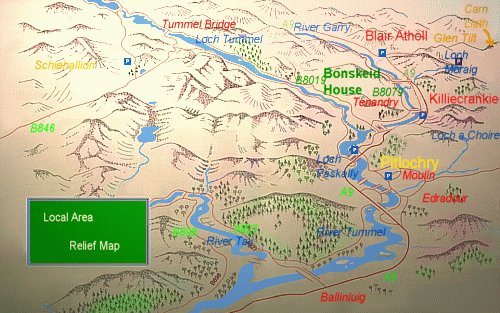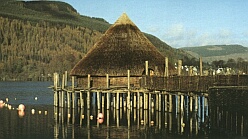

At Pitlochry and immediate surroundings are two distilleries and one brewery. One is Blair Atholl Distillery, actually in Pitlochry, watered by the Allt Dour (the burn of the otter). There is also the smallest distillery in Scotland, Edradour Distillery. An inn at Moulin, just outside Pitlochry, has its own brewery. Moulin also contains a ruined castle. There is the Festival Theatre in Pitlochry, and summer Monday nights include pipe band music.
Pitlochry Dam has a ladder for salmon, with a viewing gallery, and a visitor centre explains the salmon story. In the centre is an explanation by Scottish Power of the development of hydro electric schemes. By Loch Faskally is Faskally Wood (mixed).
At Killiecrankie is the National Trust for Sotland Visitor Centre. The Pass of Killiecrankie is a wooded gorge. Here is the "Soldier's Leap" (of the battle in 1689). See the article.
Blair Castle shows off a fine woodland with collected species in Diana's Grove. There are grottos and viewpoints.  It has its own trails and the Hercules Garden. There is a deer park, highland cattle, nature trails, peacocks and a play area. Home of the Duke of Atholl, it shows his collection of Highland and Jacobite militaria, the Atholl Highlanders (the Duke of Atholl's private army) display, paintings, furniture, china, lace and embroidery in 32 furnished rooms and represents Scottish history from the 1500's to the present. In later May the Atholl Highlanders parade and a piper plays in front of the castle during the season.
It has its own trails and the Hercules Garden. There is a deer park, highland cattle, nature trails, peacocks and a play area. Home of the Duke of Atholl, it shows his collection of Highland and Jacobite militaria, the Atholl Highlanders (the Duke of Atholl's private army) display, paintings, furniture, china, lace and embroidery in 32 furnished rooms and represents Scottish history from the 1500's to the present. In later May the Atholl Highlanders parade and a piper plays in front of the castle during the season.
Four miles to the north east of Blair Atholl is the Beinn a' Ghlo ridge consisting of three mountains. Loch Moraig lies below.
Loch a Goire is reached from an open hill and stands at the base of Ben Vrackie. Ben Vrackie itself is the backdrop to Pitlochry, and offers views up the Tummel valley, over Bonskeid, Loch Tummel, and on to Rannoch, Glen Coe and Ben Nevis. Dominating the skyline south of Pitlochry is the Clunie Ridge.
Glen Tilt has waterfalls, steep gorges, a ruined settlement (it was once a well populated upland glen with its own history), open moorland and bleak upper reaches.
Aberfeldy has a local whisky distillery and water mill. The Birks of Aberfeldy consists of a woodland gorge & waterfalls made famous by Robert Burns. On Loch Tay is the re-constructed crannog where prehistoric families lived in buildings stood in water.  Crannogs were quite common in Scotland and Ireland, and were a defence from invaders, and were lived in from as far back as 5000 BCE until the 1800's CE. The piles were hand-driven into the loch and crosspices supported the foundations, and the timber came from the woodland. Peaty water well preserved the remains for archaeologists and the site on the Loch is based on findings at Fearnan not too far away. The Scottish Crannog Centre gives a sense of time travel and gives some hands on experience. At Fortingall is the oldest living tree in Europe, being over 2000 years old.
Crannogs were quite common in Scotland and Ireland, and were a defence from invaders, and were lived in from as far back as 5000 BCE until the 1800's CE. The piles were hand-driven into the loch and crosspices supported the foundations, and the timber came from the woodland. Peaty water well preserved the remains for archaeologists and the site on the Loch is based on findings at Fearnan not too far away. The Scottish Crannog Centre gives a sense of time travel and gives some hands on experience. At Fortingall is the oldest living tree in Europe, being over 2000 years old.
Schiehallion has certain mystical overtones and its said snow-like appearance comes from its quartzite strewn boulder fields. Obviously the mountain gives off spectacular views of the Glen Coe range and more (depending on the weather, of course). Glenmore is the valley overlooked by Schiehallion mountain. Nearby is Kinloch Rannoch and at the end of the road is Rannoch Station, an attraction in itself, and although cars can go no further it is possible to walk over to the main road to the West Highlands and Islands.
The Highland Folk Museum is split between two sites at Kingussie and nearby Newtonmore. They both show four hundred years of every day ordinary Highland social life from clans people to contemporary crofters. Newtonmore shows off whole reconstructed buildings and their environment according to period skills. These skills are demonstrated at Kingussie and Newtonmore, most fully for visitors in July and August and transport links both sites.
| Click Bonskeid on the main menu to restore left menu |